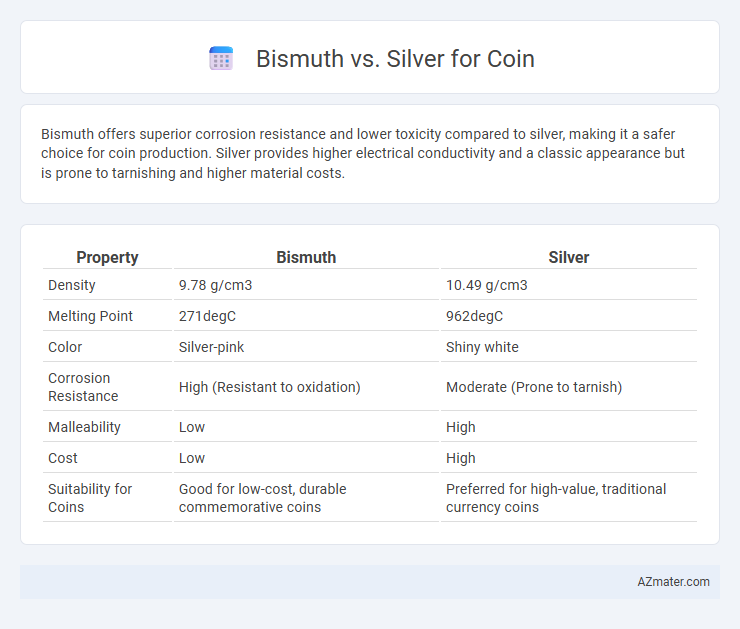Bismuth offers superior corrosion resistance and lower toxicity compared to silver, making it a safer choice for coin production. Silver provides higher electrical conductivity and a classic appearance but is prone to tarnishing and higher material costs.
Table of Comparison
| Property | Bismuth | Silver |
|---|---|---|
| Density | 9.78 g/cm3 | 10.49 g/cm3 |
| Melting Point | 271degC | 962degC |
| Color | Silver-pink | Shiny white |
| Corrosion Resistance | High (Resistant to oxidation) | Moderate (Prone to tarnish) |
| Malleability | Low | High |
| Cost | Low | High |
| Suitability for Coins | Good for low-cost, durable commemorative coins | Preferred for high-value, traditional currency coins |
Introduction to Bismuth and Silver in Coinage
Bismuth and silver represent distinct materials in coinage, each offering unique properties and historical significance. Silver, valued for its durability and intrinsic worth, has been a preferred metal for coins for centuries, often symbolizing wealth and stability. Bismuth, a heavier, brittle metal with low toxicity and a distinctive iridescent hue, is gaining attention in niche coin applications for its environmental benefits and unique aesthetic qualities.
Historical Use of Bismuth and Silver for Coins
Silver has been a primary metal for coinage throughout history due to its durability, luster, and intrinsic value, prominently used by ancient civilizations such as the Greeks and Romans to mint currency. Bismuth's historical use in coins is minimal and largely experimental, as its brittleness and lower value limited its adoption compared to traditional metals like silver and gold. While silver coins facilitated trade and economic stability for centuries, bismuth's role remained peripheral, primarily in modern alloys rather than as a standalone coinage metal.
Physical Properties: Bismuth vs. Silver
Bismuth exhibits a density of approximately 9.78 g/cm3 and a melting point of 271.5degC, making it significantly heavier and more brittle than silver. Silver, with a density of 10.49 g/cm3 and a melting point of 961.8degC, offers superior malleability and ductility, essential for intricate coin designs and durability. The higher thermal and electrical conductivity of silver enhances its use in coinage compared to the lower conductivity and brittleness of bismuth.
Visual Appearance and Aesthetics
Bismuth coins showcase iridescent, rainbow-hued crystals with a geometric, stair-step pattern that creates a futuristic and unique visual appeal, contrasting sharply with silver coins, which feature a classic, polished metallic luster and timeless elegance. Silver offers a smooth, reflective surface with a bright white sheen that ages to a subtle patina, enhancing its traditional aesthetic and historical value. Bismuth's vibrant color shifts and textured morphology cater to collectors seeking striking, distinctive designs, while silver appeals to those appreciating refined, enduring beauty and high intrinsic value.
Durability and Wear Resistance
Bismuth coins exhibit lower durability and wear resistance compared to silver coins due to bismuth's brittleness and lower hardness. Silver's higher malleability and intrinsic hardness contribute to superior resistance against abrasion and deformation, making it more suitable for long-lasting coinage. The wear resistance of silver ensures extended circulation life, while bismuth is prone to surface scratches and structural damage under frequent handling.
Cost and Market Value Comparison
Bismuth coins typically have a lower production cost due to the metal's abundance and easier extraction compared to silver, which is rarer and more expensive to mine. Silver coins maintain a higher market value driven by silver's established status as a precious metal and its demand in jewelry, electronics, and investment markets. Despite bismuth's affordability and unique properties, silver's intrinsic value and liquidity make it a more popular choice among collectors and investors.
Collectability and Investment Potential
Bismuth coins offer unique iridescent colors and intricate crystal formations, attracting niche collectors who value artistic and scientific appeal, whereas silver coins maintain longstanding popularity due to their intrinsic metal value and historical significance. Silver's liquidity and stable market demand provide consistent investment potential, while bismuth's rarity and novelty may yield higher appreciation in specialized markets but come with greater volatility. Collectors often seek bismuth coins for their visual uniqueness, whereas investors prefer silver coins for their proven track record as a hedge against inflation and economic uncertainty.
Environmental Impact and Sustainability
Bismuth offers a significantly lower environmental impact compared to silver due to its non-toxic nature and abundant availability, reducing mining pollution and ecological disruption. Silver extraction often involves energy-intensive processes that release harmful pollutants, whereas bismuth's extraction and recycling processes are more sustainable and less damaging to ecosystems. Using bismuth in coins promotes circular economy practices by minimizing resource depletion and supporting eco-friendly manufacturing methods.
Modern Applications in Coin Minting
Bismuth offers unique advantages in modern coin minting due to its non-toxic nature and lower environmental impact compared to silver. While silver remains prized for its durability and traditional aesthetic appeal in collectible coins, bismuth's distinct iridescent colors and ease of alloying make it increasingly popular for innovative designs and limited-edition releases. Coin mints are exploring bismuth alloys to enhance sustainability and introduce visually striking, corrosion-resistant coins that appeal to contemporary collectors.
Summary: Choosing Between Bismuth and Silver for Coins
Bismuth offers a lightweight, corrosion-resistant alternative to traditional silver for coin production, ideal for collectors seeking unique metal properties. Silver provides superior value retention, intrinsic worth, and historical significance, making it the preferred choice for investment-grade coins. The decision depends on prioritizing aesthetic uniqueness and affordability with bismuth or valuing long-term stability and market demand with silver.

Infographic: Bismuth vs Silver for Coin
 azmater.com
azmater.com